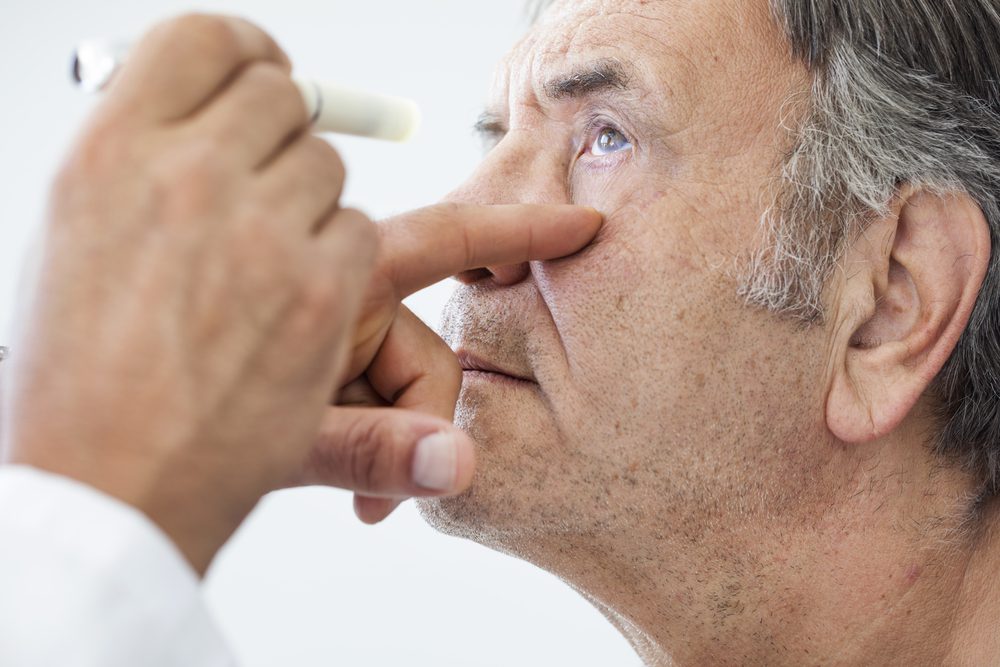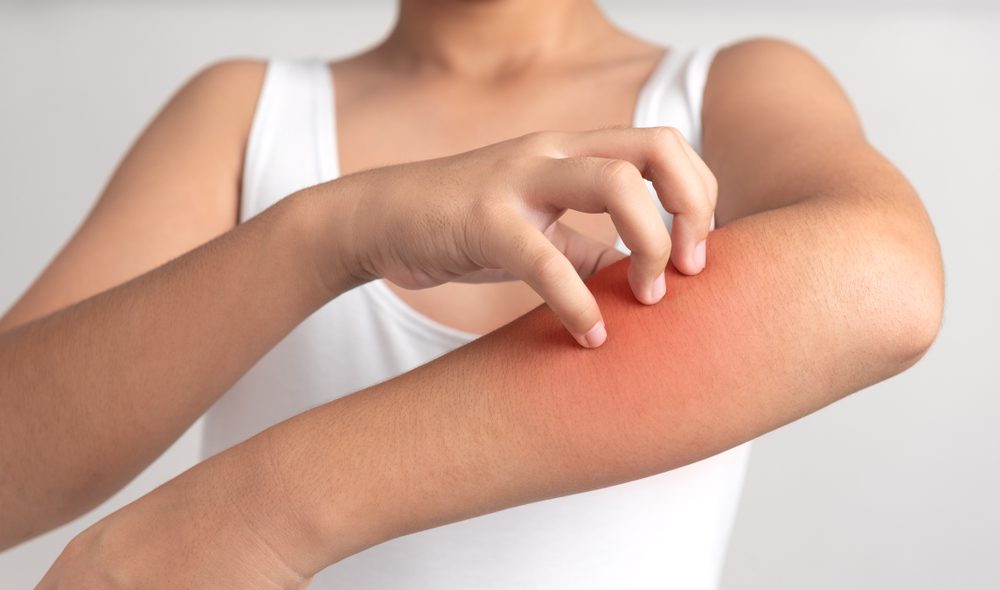
Is it possible to have had COVID-19 without realizing it? The answer is YES. “The majority of people who contract the coronavirus will experience mild symptoms, the most common being a high temperature and a new, dry, and continuous cough. A smaller percentage of people will experience more severe symptoms,” explains Dr. Daniel Atkinson, GP Clinical Lead at Treated.com.
According to recent studies, the coronavirus started spreading in countries way earlier than people first spotted it, which means it’s not that preposterous to believe that some people may have already been infected with the virus and recovered without knowing they ever had it. More than that, at a closer look, you may realize you’ve experienced some of the main symptoms associated with coronavirus too. If you want to make sure, read on to find out 14 signs you’ve already had coronavirus earlier this year.

Runny Nose, Sore Throat, and Congestion
According to Dr. Atkinson, if you’ve experienced these three symptoms earlier this year, you might have been struck by COVID-19 without realizing it. But because it “sounds, and likely feels, a lot like the common cold, or a hay fever allergy,” many people most probably dismissed them and kept going about their day-to-day lives.
Reduced, or Loss of, Sense of Taste and Smell
If you previously lost your sense of taste and smell you could have already contracted the coronavirus. “It’s a symptom that might accompany really mild symptoms, like those not dissimilar to the common cold—runny nose, congestion, and sore throat—but it can also accompany the very mild symptoms, such as muscle aches, fatigue, fever and a continuous cough,” Dr. Atkinson explains.
According to the British Association of Otorhinolaryngology, there is “evidence from other countries that the entry point for the coronavirus is often in the eyes, nose and throat areas. We have also identified a new symptom (loss of sense of smell and taste) that may mean that people without other symptoms but with just the loss of this sense may have to self-isolate – again to reduce the spread of the virus.” Dr. Atkins pointed out that in most cases, people regained these senses in maximum six weeks.

Tiredness and Fatigue
Another symptom that many of the coronavirus patients reported, in most cases along with fever and dry cough, is extreme fatigue. In fact, according to the Journal of the American Medical Association, about 44 percent of those hospitalized with Covid-19 reported this symptom.
The main reason is that your body consumes energy to fight against infections. “Most people will feel tired or lethargic so won’t be exercising or going to work when they’re ill, but some fitness enthusiasts insist on continuing with exercise to try and battle on through,” explains Dr. Atkinson. If you continue to push your body beyond its limits, you’re not doing it any good. That’s because you don’t allow it to rest physically so that your immune system could do its job. “You should not ignore your body’s signals,” Atkinson adds. “Resting and sleeping while you’re unwell is an essential part of your recovery.”
Shortness of Breath
The novel coronavirus is notorious for being a respiratory infection, which means coughing, having a sore throat and shortness of breath can be a manifestation of the viral infection, explains Dr. Atkinson. Breathlessness can occur on its own, without a dry cough. If your chest becomes tight or you feel as if you cannot breathe deeply enough when you’re at rest, then it might be (or could have been) a sign that you contracted the scary bug.

Reduced Appetite
It’s not only your taste or smell that might be affected by the coronavirus. Your appetite can also take a hit. “If this is accompanied by a loss of taste and smell it can make wanting to eat or drink really difficult,” he explains. “It’s really important to drink plenty of fluids to help your body combat the virus and minimize the symptoms and even if you don’t feel like it, try to eat something, even if it’s just a snack or a small meal.”
COVID Toes
What exactly are COVID toes? According to dermatologists, these are purple skin lesions tied to Covid-19 which appears on patients’ toes (sometimes hands). Most of the times, this symptom is experienced by otherwise asymptomatic children and young adults.
“Most of the patients were young, healthy, and had a benign clinical course,” says Dr. Esther Freeman, a dermatologist at Massachusetts General Hospital in Boston. “I don’t want people to think if they are having purple spots on their toes that they are going to end up on a ventilator in the ICU. That is not what we are seeing in the data.” Not every purple skin lesion is an indicator of coronavirus. There are also other subtle differences that allow doctors to differentiate COVID-19 infection cases from simple skin rashes.
“Swollen toes and feet might also be related to venous thrombosis and poor return of the blood to the heart rather than poor blood flow to the toes,” says interventional radiologist Hamid Mojibian, MD, of Yale Medicin, which is why it’s important to see a doctor if you notice this unusual symptom.
“The good news is that the chilblain-like lesions usually mean you’re going to be fine,” says Dr. Fox, who practices at the University of California, San Francisco. “Usually it’s a good sign your body has seen COVID and is making a good immune reaction to it.”

Conjunctivitis
If you have recently had conjunctivitis, it could have been a side-effect of COVID-19. “Several reports suggest that SARS-CoV-2 can cause mild follicular conjunctivitis otherwise indistinguishable from other viral causes, and possibly be transmitted by aerosol contact with conjunctiva,” reported the American Academy of Ophthalmology. This is why some medical and public health experts are recommending people to wear glasses during the pandemic (especially those wearing contact lenses and need to touch their eyes all the time)
However, according to the College of Optometrists, “it is unlikely that a person would present with viral conjunctivitis secondary to Covid-19 without other symptoms of fever or a continuous cough as conjunctivitis seems to be a late feature where is has occurred.”
Fever Spike
Fever is the most common symptom of coronavirus infection. If you’ve had fever episodes that came and went just like that, you might have been infected with the novel coronavirus. The World Health Organization announced that 87.9% of 55,924 laboratory-confirmed cases of coronavirus reported a fever, turning it into a key coronavirus symptom. According to doctors, the best way to tell if you have a fever is if you feel hot to touch on your chest or back.

Muscle Pain
Muscle pains can have many underlying causes, from overexertion to injuries or the flu. But recently, the CDC added muscle pain on the list of coronavirus symptoms.
“Most of the time, people get generalized achy muscles that you can have with any kind of viral infection, and it goes away as you recover from the virus. If you feel generally OK otherwise, you’re probably not dealing with COVID-19,” says Dr. Adalja M.D., senior scholar at the Johns Hopkins Center for Health Security. “But if it’s focal, meaning it’s just in your leg or another area of your body, or if your urine gets dark (which can be a sign of kidney damage), call your doctor.”
More than that, according to Dr. Amir Barzin, DO, MS, incident commander for the Respiratory Diagnostic Center at UNC Medical Center in Chapel Hill, the muscle pain associated with COVID-19 usually feels like “tenderness to the touch of the muscle or pain with movements of the muscle”, so pay attention to that as well.
Diarrhea or Nausea
The CDC informed that “some persons with COVID-19 have experienced gastrointestinal symptoms such as diarrhea and nausea prior to developing fever and lower respiratory tract signs and symptoms.”
As a matter of fact, according to a study published in The American Journal of Gastroenterology, digestive problems were more prevalent in patients diagnosed with COVID-19 than previously thought. Data from more than two hundred patients infected with Covid-19 in China’s Hubei province was analyzed and the result was that 48.5 percent of these patients were brought to the hospital with digestive symptoms such as diarrhea, vomiting or abdominal pain.

Disorientation
It has not been officially added to the COVID-19 symptoms’ list, but a small percent of coronavirus patients has also reported feeling confused and disoriented. According to a study published in the Journal of the American Medical Association, more than a third of coronavirus patients hospitalized in Wuhan, China, manifested neurological symptoms including loss of balance or coordination, loss of consciousness, and strokes.
“You’ve been hearing that this is a breathing problem, but it also affects what we most care about, the brain,” warns S. Andrew Josephson, chair of the neurology department at the University of California, San Francisco. “If you become confused, if you’re having problems thinking, those are reasons to seek medical attention,” he adds.
Dry Cough
A dry cough is one of the three most common symptoms of coronavirus, along with fever and shortness of breath. This trifecta was experienced by 80 percent of those infected with COVID-19, according to the WHO.
But what is a dry cough and how do you differentiate it from a wet cough? Well, according to Subinoy Das, MD an Ohio-based ear nose and throat physician, and medical director for the US Institute for Advanced Sinus Care & Research, a dry cough is “one where no mucus or phlegm is produced with the cough.” More than that, “it has a very consistent sound” caused by the fact that “the airway is not constantly changing with the cough” like in the case of a wet cough when the “mucus expectorates or leaves the chest with each [wet] cough.”

COVID Rashes
“The skin is often a window into a person’s health and may show signs of COVID-19 infection,” explains Dr. Nelson. Experts discovered that apart from COVID toes, patients can also exhibit itchy and sometimes painful skin rashes. “Other rashes can look kind of like chickenpox, where they will get like little bumps on people’s bellies and their backs. And we also can see something that looks sort of like a pink lacy pattern that develops on people’s arms and legs,” says Dr. Michelle Daffer, Dermatologist at Midlands Clinic.
“It’s unclear whether the skin lesions we see in COVID are actually a direct manifestation of the virus” in the skin, or a “reaction pattern” due to an overworked immune system, explains Dr. Kanade Shinkai, a professor of dermatology at the University of California, San Francisco.
Chills or Repeated Shaking with Chills
Among the six new coronavirus symptoms officially recognized by the CDC, we also have chills or repeated shaking. This symptom is usually combined with a fever.
The term “chills” refers to a feeling of being cold for no apparent reason. Your muscles repeatedly expand and contract and the vessels in the skin constrict because your body is trying to produce heat. In a study that analyzed the data from 55,924 patients in China, from the date the virus was first identified to February 22, 11.4 percent of coronavirus patients reported feeling chills and repeated shaking and shivering.
How Do You Know for Sure If You’ve Already Had Coronavirus?
Dr. Atkinson suggests using an antibody test which confirms whether or not you had been infected with the virus in the past. The CDC informed that such tests are “slowly becoming available through healthcare providers.” The result might surprise you!
























14 thoughts on “14 Signs You’ve Already Had Coronavirus Earlier This Year”
Please provide me with more about testing if you think you have already had the virus and an antibody test. Thank you.
I have COVID arm baseball size lump with itching. What should I do? I have had it for 3 days. I had the Moderna injection on 1/30/2021
This was a good report for all. I just got my first Pfizer vaccine on February 12. 2021. Looking forward to my second vaccine in 21 days or so. I have had symptoms of Covid 19 such as high fatigue. I hope I get beyond and recover after a year of staying home with my puppy. Thank you.
EXCELLENT 1000 TIMES
I had the virus then I got the shot, after being over the virus for good month and a half, I had the vaccine. I thought it was going to die, it was so bad. I could not move my arms or lift them. I could not lift my legs, the pain was a 10 + if not 100. My head felt like it was going to explode and I blew up like a balloon. I gained 25 pounds of water weight in two weeks. Not to forget fever, chills, nausea, double over stomach pain .I had the Pfizer vaccine.
I had all these in November, but COVID toes and rash. I had positive test. December I could not move my arms(proximal pain in both humerus and femurs) I was admitted for nine days and had many tests. I’m being treated fir myasthenia gravis now. Are there similar reports?
I have myasthenia gravis for over 20 years. I had the Pfizer vaccine last shot feb 5 . Didnt feel up to par after for 3 days but okay now but I am a little more tiered than usual. Hope your dr is giving you a steroid and mestinon for your myasthenia it works great. You should be feeling much better . When I first got it it took about 3 months to get my life back close to normal. Just remember not to push yourself to much if you get tired sit and rest a few minutes. good luck
Does anyone know how long the antibodies stay in your system after you have had the covid-19?
I have had my second dose of Moderna vaccine. The first dose was fine with very few after effects.
However, the second dose put me in bed for more than 24 hours. I was told today that one needs to drink
lots of water before and after the shot. I did not do that which probably made my reaction more server.
My husband who drinks lots of water all the time did not have any reaction after his 2nd shot.
My 84 yr old wife got severe headache and cold body symptons after her first Moderna shot. Can she expect the same reaction after her second shot ?
I got the moderna on 2/12/21. The only side effect I and my husband napped for awhile afterwards and have been fine ever since. My arm ached but not as much as the flu vaccine.
1/16/20
One of my coworkers went Hendersville to a bowling alley. Out of 3 people he was the only one that ended up with type A B flu and gave it to me at work.
He was out a week and so was I. I had a high fever, no taste or smell and no appetite on my 2nd day I went to my doctor and that’s where they diagnosed me and gave me a Z-Pac and a shot for the headaches and sore muscles for pain.
After the 4th day I began to get my energy back and eat just enough to take the medicine.
Tell me was this covid19 fresh out the gate.
I’ve been tested, and inoculated , and the test revealed I’ve never had the virus , and any symptoms I’ve experienced was due to the side effects of the shot. So far, so good!
The funny thing about our nation and media is….we all have probably had Covid 19 several times. receiving it through the nose and not getting very sick from it (60%) anyway. People now are willing to get a new mRNA vaccine in a fatty molecule into their bloodstream which will cause a much greater and potentially more dangerous reaction than the ones we’ve already had with the wild virus. We were probably all naturally vaccinated before we even went on lockdown. Remember the people that had the vape illness Summer of 2019, 3 months then disappeared.? These were people that had been vaping for 4 years and suddenly developed an acute respiratory? distress? Sounds infective yet not the flu. Then in Sept 2019 when all the kids went back to school the high schoolers and college kids were developing diarrheal illness with hand foot and mouth symptoms, and then our high school kids developed chrohns, low blood pressure issues, rheumatoid arthritis, all that fall. afterward. They got it again with coughing in January, some very sick in bed and not the flu.
If you check with the doctors in AFLDS.com they will tell you this vaccine has already cause 4000 deaths and hundreds of thousands of serious adverse affects of which we are not hearing on the news because of Big Pharma sponsors. Wake up everyone!!! protect yourselves.